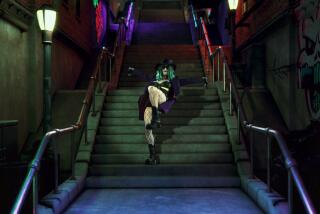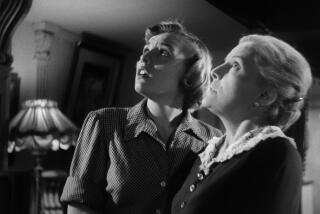Robert Drew dies at 90; pioneer of documentary filmmaking
Robert Drew had no experience in filmmaking when he directed the 1960 documentary âPrimaryâ that was radically different from the way TV documentaries were made at the time.
Drewâs film, about relatively unknown Sen. John F. Kennedy campaigning in Wisconsin, had no interviews, no correspondents and just the barest of narration. For the most part, Drew and his crew just turned on their cameras and filmed what happened in a documentary style that came to be known as cinema verite.
âIt would be theater without actors, it would be plays without playwrights,â he said in a 1962 interview with Alfred Norrins. âIt would be the ability to look in on peopleâs lives at crucial times from which you could deduce certain things and see a kind of truth.â
Drew, 90, died Wednesday at his home in Sharon, Conn. The cause was sepsis, said his daughter, Lisa Drew.
Robert Drew produced and directed scores of documentary films, mostly for television, during a career that spanned more than four decades. Many were about politics and current issues. His film âThe Chair,â for example, about a criminal scheduled to be executed, won a 1962 special jury prize at the Cannes Film Festival. But Drew also focused on the arts in documentaries such as âJaneâ (1962), about the launching of a Broadway play starring Jane Fonda that turned out to be a flop, and the Emmy-winning âMan Who Dancesâ (1968), about the sheer physical rigors endured by ballet star Edward Villella.
He made several documentaries in Los Angeles, including âFire Season,â about a Latino gang member who leaves his gang to join the California Conservation Corps to fight fires, and âWarnings from Gangland,â about a grocer who fights back against gang attacks. Both were shown on PBS in the 1980s.
But itâs likely that his most influential work was âPrimaryâ with the pioneering, unorthodox style that he was to use throughout his career. Drew â who was a high-school dropout and fighter pilot whose exploits during World War II could have been fodder for a Hollywood movie â may have not previously made a film. But as a reporter and photo editor for Life magazine, he knew how to tell a story with pictures. And he felt television news was failing at that.
âAt the time, most film documentaries were verbally based, and that creates two problems,â he said in a 1993 Times interview. âFirst, itâs deadly dull, because a lecture on a living medium is always dull. Second, that approach obstructs any dramatic development that has the potential of unfolding.
âSo I decided to kill the narration and get the candid footage going.â
With financing from Time-Life, according to a Washington Post story, he oversaw the engineering of a film/sound unit that was technically portable, though it weighed 50 pounds and took two people to carry. The resulting hourlong film, which captured Kennedyâs vibrant energy and magnetism on the stump, was turned down by NBC. It was eventually slashed to less than a half-hour and shown on stations owed by Time-Life and RKO, the Post said. But the film got a far better reception in France, where it was show theatrically.
Drew showed the film to Kennedy after his 1960 election victory. âI told him, âWhat we have here is a new form of history,ââ Drew said in the Times interview. The filmmaker went on to make the documentary âCrisisâ about the Kennedy administrationâs clash with Alabama Gov. George Wallace over the governorâs attempt to block black students from enrolling at the University of Alabama.
Drewâs last film about Kennedy, âFaces of November,â was an 11-minute short that focused on the faces of people â famous and not â mourning the death of the assassinated president.
Robert Drew was born Feb. 15, 1924, in Toledo, Ohio. The family moved when he was young to Ft. Thomas, Ky., where his father ran a seaplane business and taught his son how to fly.
He left high school shortly before graduation to join the Army and was posted to a combat squadron near Naples, Italy. He flew 31 missions before being shot down behind enemy lines on Jan. 31, 1944, at the age of 19. Drew survived in the mountainous area for three and a half months, partly because people shared the scarce food they had. âThis whole area was full of refugees, Italians bombed out of their villages, partly by me,â he told the Hartford Courant in 2008. âItalians are compassionate people.â
He finally made his way back to his squadron without getting caught by enemy forces. One of his last films, âTwo Men and a Warâ (2005), tells the story of what happened to him in Italy and also his friendship with famed journalist Ernie Pyle. For that film, he abandoned his cinema verite technique. It used music and even narration.
âWith verite films, you are there observing something happening,â he said in the Courant interview. âThis one talked about something that happened years ago.â
In addition to Lisa Drew, who lives in Fairbanks, Alaska, Robert Drew is survived by sons Thatcher Drew of Bronxville, N.Y., and Derek Drew of Washington, D.C.; brother Frank Drew of Waco, Texas; sister Mary Way Drew Greer of Palmdale and three grandchildren. His second wife, Anne Drew, who produced several of his films, died in 2012.
Twitter: @davidcolker
More to Read
Start your day right
Sign up for Essential California for the L.A. Times biggest news, features and recommendations in your inbox six days a week.
You may occasionally receive promotional content from the Los Angeles Times.







